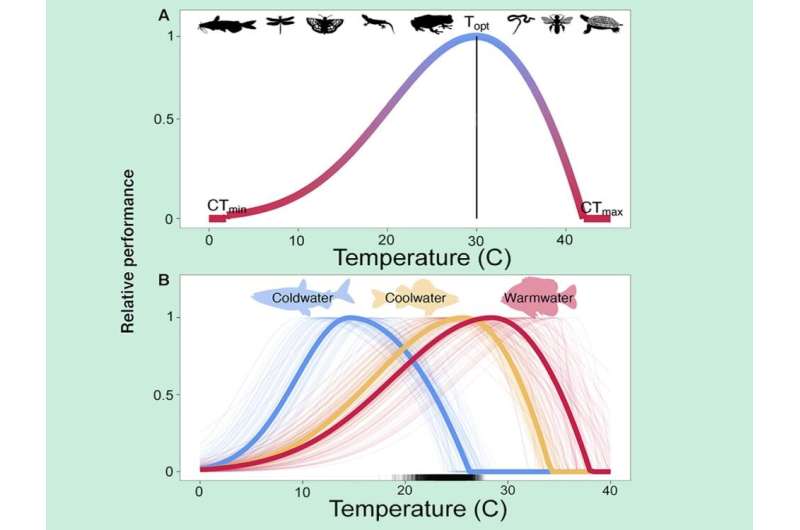Innovative method predicts the effects of climate change on cold-blooded animals

In the face of a warming climate that is having a profound effect on global biodiversity and will change the distribution and abundance of many animals, a Penn State-led research team has developed a statistical model that improves estimates of habitat suitability and extinction probability for cold-blooded animals as temperatures climb.
Cold-blooded animals—a diverse group including fish, reptiles, amphibians and insects—comprise most species on Earth. The body temperature of cold-blooded animals is strongly influenced by the temperature of their environment. Because their growth, reproductive success and survival is tightly coupled to environmental temperatures, climate change represents a significant threat to them.
Understanding the future effects of climate change on biodiversity is a global priority, according to research team leader Tyler Wagner, a scientist with the U.S. Geological Survey and a Penn State adjunct professor of fisheries ecology. But predicting where a species will exist and in what abundance under future temperatures is extremely challenging, he noted, because for many species this means estimating responses to temperatures that the animals have not yet experienced, and scientists have not yet observed.
To more precisely estimate the effects of climate change on cold-blooded animals, in a new study, the researchers developed a statistical method to fuse data collected in the field describing the distribution and abundance of many cold-blooded animals with laboratory-derived information about species-specific temperature performance and tolerance.
In findings published today in the Proceedings of the National Academy of Sciences, Wagner and colleagues report the development of an innovative statistical modeling approach. Their newly developed model, which they call the “Physiologically Guided Abundance Model,” or PGA Model, can be applied across almost all cold-blooded animals, and is believed to have great potential to help inform the formation of climate adaptation and management strategies.
“The challenge was how to combine these two sources of information and use laboratory-derived information to help inform landscape-scale predictions under future climates not experienced by animals in their current ranges,” said Wagner, who is assistant unit leader of the Pennsylvania Cooperative Fish and Wildlife Research Unit in the College of Agricultural Sciences. “The model we created accomplishes that.”
The PGA model combines observations of species abundance and environmental conditions with laboratory-derived data on the physiological response of cold-blooded animals to temperature to predict species geographical distributions and abundance in response to a warming world. Without including species’ physiological preferences in a model, Wagner suggests, it is difficult to realistically forecast cold-blooded animals’ fate.
“When trying to predict, or extrapolate, the effects of climate change on animal distribution and abundance, scientists now often only use information that describes the relationships between abundance and distributions and temperature under current conditions,” he said. “These relationships are then used to extrapolate under future temperature conditions.”
However, this approach assumes that species-environment relationships are biologically meaningful under future temperatures and, importantly, fails to account for the tight link between environmental temperatures and cold-blooded animal physiology, Wagner explained.
“Although cold-blooded animals are understudied when it comes to understanding how their distributions and abundance will respond to climate change, these animals are relatively well-studied when it comes to laboratory-derived information about how changes in environmental temperatures affect physiology and performance,” he said. “In fact, most cold-blooded animals share a similar functional response in relative performance with increasing temperatures, which can be generalized across a diversity of taxa.”
The researchers developed their PGA model using data from three fish species that differ in their thermal preference and tolerance across more than 1,300 lakes located in the U.S. Midwest. They compared the PGA model’s results to those from a traditional model that does not incorporate species’ physiological responses. Fishes considered in the research were cisco (coldwater), yellow perch (coolwater) and bluegill (warmwater).
The researchers predicted species distributions and abundance at each lake under current conditions and for 1.8-, 3.6-, 5.4- and 7.2-degree Fahrenheit (1, 2, 3, 4 degree Celsius) increases in mean July water temperatures. A 7.2-degree F (4 C) increase corresponds to the predicted average regional increase in air temperature across the Midwest region for the 2071–2100 time period.
While the results of the traditional model did not predict that any of the fish species would be extirpated, or locally driven out, by climate change, the PGA model revealed that cold-adapted fish would be extirpated in 61% of their current habitat with rising temperature.
Gretchen Hansen, assistant professor at the University of Minnesota and a co-author on the study, suggested that models that do not include physiological preferences may lead to underestimations of the risk climate change may pose to cold-adapted species.
“We showed that temperature-driven changes in distribution, local extinction, and abundance of cold-, cool- and warm-adapted species varied substantially when physiological information was incorporated into the model,” she said. “The PGA model provided more realistic predictions under future climate scenarios compared with traditional approaches and has great potential for more realistically estimating the effects of climate change on cold blooded species.”
Also contributing to the research at Penn State was Christopher Custer, doctoral degree student in the Department of Ecosystem Science and Management; as well as Erin Schliep, Department of Statistics, North Carolina State University; Joshua North, Climate and Ecosystem Sciences Division, Lawrence Berkeley National Laboratory; and Holly Kundel and Jenna Ruzich, Department of Fisheries, Wildlife, and Conservation Biology, University of Minnesota.
More information:
Wagner, Tyler, Predicting climate change impacts on poikilotherms using physiologically guided species abundance models, Proceedings of the National Academy of Sciences (2023). DOI: 10.1073/pnas.2214199120. doi.org/10.1073/pnas.2214199120
Citation:
Innovative method predicts the effects of climate change on cold-blooded animals (2023, April 3)
retrieved 4 April 2023
from https://phys.org/news/2023-04-method-effects-climate-cold-blooded-animals.html
This document is subject to copyright. Apart from any fair dealing for the purpose of private study or research, no
part may be reproduced without the written permission. The content is provided for information purposes only.
For all the latest Science News Click Here
For the latest news and updates, follow us on Google News.

